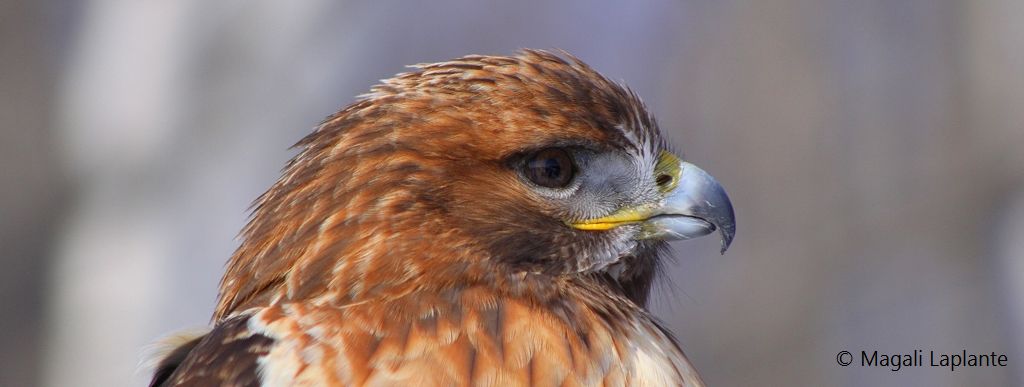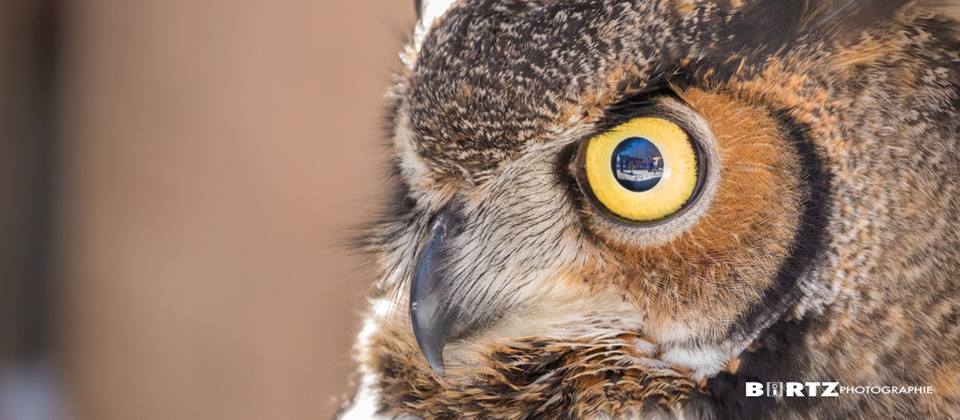Rehabilitation Guides
Below are a few references about the rehabilitation of wild birds:
In English
In French
-
Guide de réhabilitation d'oiseaux de proie (Bulletin L'Envol, volume 6 numéro 1)
Vidéos sur les premiers soins
- Comment faire un examen physique complet?
- Comment faire un bandage en huit de l'aile dans un cas de fracture?
- Comment administrer des fluides oraux pour réhydrater un oiseau?
Reportages et histoires de réhabilitation d'oiseaux de proie :
- Préparation d'un pygargue à tête blanche pour sa remise en liberté à Chouette à voir!
Sites intéressants
Annonces de formation
Birds of Prey Clinic
The Birds of Prey Clinic of the Faculté de médecine vétérinaire of the Université de Montréal was created in 1986. It was founded by Dr. Guy Fitzgerald, who was a veterinary student at the time, and who is still the clinician in charge of the clinic's activities. It is this clinic that is appointed by UQROP to provide veterinary care to all the approximately 350 injured birds of prey we receive per year.
The Birds of prey Clinic is supported financially by the Faculté de médecine vétérinaire (Faculty of Veterinary Medecine) and UQROP. Its location within this faculty allows birds of prey to receive high quality care in order to ensure them the best chances of healing. The Birds of Prey Clinic also has an educational objective in contributing to the training of hundreds of veterinarians in the field of wildlife medicine and wild bird rehabilitation.
Neither UQROP nor the Faculté de médecine vétérinaire receive recurrent funding for the care provided to the birds.
Network participants
The UQROP team being relatively small, it is unfortunately impossible for us to travel to all the different locations throughout the province where injured birds of prey are found.
If you live near Saint-Hyacinthe, find an injured bird of prey and are available transport it, the fastest solution is to call the Birds of Prey Clinic, explain the situation to the veterinarians and notify them that you are coming to drop off the bird.
If that is not the case and you live too far from the clinic, contact your regional wildlife protection agent so that he can organize the bird's transportation as soon as possible.
Thank you for you support and your valuable help.
Steps of the rehabilitation
Finding an injured bird of prey:
According to article 67 of the Law on the conservation and promotion of wildlife (L.R.Q., c. C61.1), all bird of prey found injured or dead must be reported to a wildlife protection agent.

Evaluating the situation:
Before capturing the bird for sending him to the Birds of prey Clinic, make sure that the bird really needs help. If it is a younster, communicate with us before capturing the bird.

Capturing the bird:
Before approaching the bird, prepare a pair of gloves, a blanket and a transportation box in order to minimize the handling time and therefore the bird's stress. For the transportation box, avoid mesh cages. Instead, use a plastic or a cardboard box with holes. If possible, use shredded paper at the bottom of the box for bedding.
Always wear gloves to capture the bird of prey. Cover it with the blanket, and take control of the bird's legs. Once the legs have been immobilized, take the bird (one hand holding the bird's legs, the other on the bird's back to keep hold its wings against its body) and put it in the box.

Transport to the Birds of prey Clinic:
If you can, bring the bird to the Birds of Prey Clinic of the Faculté de médecine vétérinaire of the Université de Montréal in Saint-Hyacinthe. First, call us to make sure that somebody will be available to meet you (450-773-8521 extension 8545). If you cannot transport the bird, you can call the nearest point of service of the Ministry of Natural Resources and Wildlife (go to http://www.mrnf.gouv.qc.ca/nousjoindre/nousjoindre-faune.jsp#regions).

Medical Examination:
Upon arrival, the veterinarian on duty will examine the bird by doing a complete medical exam. Hence, the veterinarian can find visible wounds or injuries and make a preliminary diagnosis. The veterinarian usually has only limited information at the bird's arrival, and thus will do an exhaustive examination of the animal.

Care/Surgery:
Once a diagnosis has been established, the veterinarian can choose for an adapted treatment (bandage, fluids, medication, etc.). Surgeries are not uncommon because an important proportion of the birds that are received are suffering from traumatic injuries (after being hit by a car for example).

Recovery in aviary at the Birds of prey Clinic:
During the whole healing process, the injured birds are kept in seperate aviaries. The aviaries are closed and are located far away from human circulation to reduce the stress on the birds. The treatment periods are set up to be as quick as possible. Indeed, the birds of prey being wild animals, (and therefore afraid of humans) they do not appreciate their stay in the hospital.

Rest and physiotherapy at Chouette à voir!
Once a bird has healed from its injuries, it is transfered to our rehabilitation complex in Saint-Jude at Chouette à voir! (see heading Chouette à voir!). These aviairies are much bigger and in addition they are located in a natural setting. They are therefore ideal to allow the bird to get back into shape before it is released. They also allow the veterinarians to come and watch the bird fly to determine whether it is ready to be released in the wild.

Final medical exam:
When the day has come for the bird's release, it is captured by the veterinarian and undergoes a final medical exam. We make sure that no medical problems have gone unnoticed during its stay at the clinic. If a problem is found, the release is postponed. If everything is fine, the veterinarian will sharpen the bird's beak and the its claws, that often become dull during its captivity, to give him back the tools it needs to hunt properly.

Banding:
Just before the bird's release, the veterinarian will put a ring on its leg. On this ring there is an identification number and a number to call if the bird is found injured, dead or captured by biologists during the course of sampling. This will allow us to have valuable information in order to help us better understand their biology and migratory movements.

Release:
Everyone's favorite moment! Of the 350 injured birds of prey that we get on average each year, 40 to 45% of them are released back into the wild. The other's unfortunately die from their injuries or remain in captivity if they suffer from permanent injuries that would prevent them from being able to hunt (e.g. a wing amputation). UQROP is not financed to do this work. If you wish to contribute to this cause, scroll over the dropdown menu "About us", and discover different ways of helping us by scrolling over the submenu "Support/Get involved"
Help us help them!

What defines a bird of prey?
Most people believe that birds of prey differ from other bird species because they eat meat. However, other carnivorous bird species exist that are not considered to be birds of prey. For example, the great blue heron, just like the belted kingfisher, eats fish. Both these species are not considered to be birds of prey because they do not share the following characteristics:
The best way to determine if a bird is a bird of prey is to observe its feet. As opposed to birds that catch their food with their beak, birds of prey use their feet to catch and kill their prey. They therefore have very powerful toes, each one ending with a longue curved claw. These claws are called talons.

Birds of prey also have a very sharp hooked beak, which they use to rip meat apart when their prey is too big to be swallowed whole. They do not leave anything behind; they swallow every part of the carcass. What they cannot digest, the prey’s skeleton and fur for example, end up being regurgitated as regurgitation pellets. Finding these pellets at the foot of trees is a good hint that birds of prey might be present in the area. All birds of prey produce regurgitation pellets.

All birds have an excellent vision, which enables them to avoid obstacles while flying, but the eyesight of birds of prey is even more refined, and often binocular for them to better evaluate distances. It is estimated that a peregrine falcon can identify prey the size of a pigeon over a kilometer away.

Diurnal or nocturnal?
All birds of prey are classified in the following groups: Strigiformes, Falconiformes and Accipitriformes. All the owl species belong to the Strigiforme order, which, for the most part, are nocturnal, meaning they hunt at night. These birds are equipped with excellent night vision, with refined hearing, and with soft plumage allowing them to fly silently. All falcon species belong to the Falconiforme order. The Acciptriforme order regroups eagles, hawks, harriers and ospreys. All species belonging to the Falconiforme and Accipitriforme orders are exclusively diurnal, meaning they hunt only between when the sun rises and when it sets, even though their hunting habits vary from one species to the next.
Sentinels of the Sky
Like all living organisms, birds of prey occupy an important place in the environment and have an important part to play in the ecosystem’s balance. This importance is even bigger considering that they are apex predators, meaning that they are at the top of the food chain.
By eating smaller animals, they contribute to controlling their population size. Without them, prey species such as small mammals (mostly rodents), small birds, reptiles, amphibians and large insects might overpopulate an area, exceeding the amount of living beings that the area in question can handle. For example, if there is an overpopulation of lemmings (a small rodent that lives in northern Quebec), the lemmings could eat all the available plants, creating a famine affecting all other herbivores in the area. An overpopulation of rodents could also contribute to the propagation of certain diseases to the humans and animals that share their environment.






